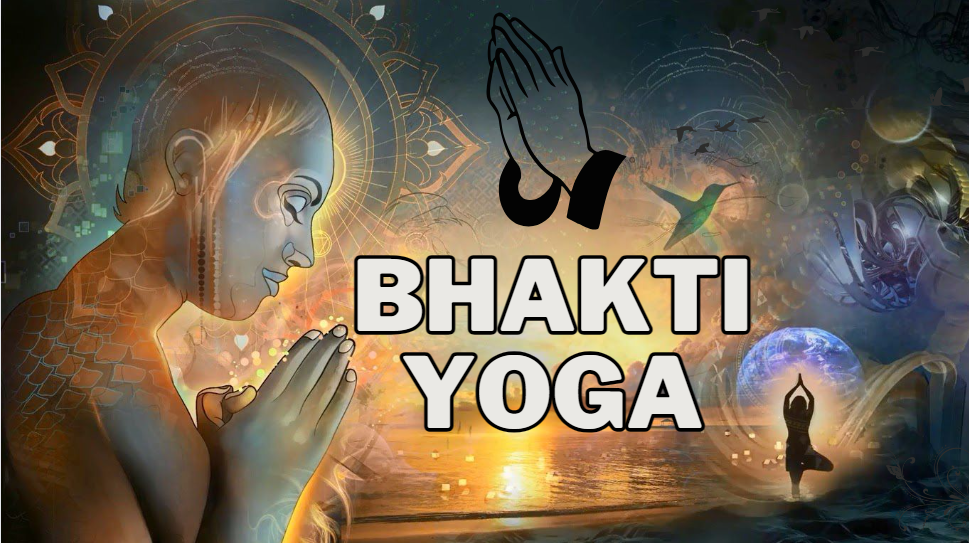Cultivate Blissful Connection: Transformative Power of Bhakti Yoga with 2 Forms
“In Bhakti, the attitude of the mind counts, not the posture of the body.” – Swami Vivekananda

Bhakti is the devotional approach of yoga, the approach of pure love. Bhakti yoga is the path of devotion and path of immense affection to reach Brahman. Bhakti is dualistic in nature. It is a triad-a triputi- there is a Bhakta or devotee; the lord or the object of devotion and there is a process linking these two called Bhakti or devotion. The Bhakta does not try to rid himself of emotions but seeks to channel and harness the emotions by sublimating them into devotion. The aspirant treading the path of bhakti attempts to realize the truth by devotion to and love of God in a personalized form.
This is Ishwara, the ishta-devata. Bhakti yoga rids the aspirant of emotions and egocentricity by developing humility, self-surrender and the feeling of being an instrument in hands of God. Bhakti appears in the heart as a seed which sprouts, blossoms, and yields fruits and spreads it’s fragrance all around enveloping all who come under its influence. India can proudly consider herself as the land of Bhakti. Millions of devotees down the ages have made this land holy. Famous Bhakti Yogis are Sriramakrishna, Surdas, Kabir Das, Purandaradasa, and Kanakadasa.
Embrace the work on Bhakti Yoga
Narada Bhakti Sutras:
The Narada Bhakti Sutras, attributed to the sage Narada, are a concise set of aphorisms that explore the essence of Bhakti. They are divided into 84 sutras, offering profound wisdom on the path of devotion. Some key points from Narada Bhakti Sutras include:
- Definition of Bhakti: Narada defines Bhakti as intense and unwavering devotion to the Supreme Being, characterized by pure love.
- Attributes of a True Bhakta: The text emphasizes the qualities of a true devotee, such as humility, love, selflessness, and an unwavering focus on the divine.
- Levels of Bhakti: Narada Bhakti Sutras describe different levels of Bhakti, ranging from initial faith to profound, selfless love. The text provides a roadmap for spiritual progression.
- Obstacles to Bhakti: Narada identifies potential obstacles to Bhakti, including ego, desire for personal gain, and lack of sincerity. Overcoming these obstacles is crucial for genuine devotion.
- Types of Devotion: The text categorizes Bhakti into various types, including Sakamya Bhakti (devotion with desires) and Nishkamya Bhakti (selfless devotion). It guides practitioners toward the highest form of unconditional love.
Shandilya Bhakti Sutra:
The Shandilya Bhakti Sutra is another ancient text dedicated to Bhakti Yoga. Attributed to Sage Shandilya, it provides insights into the principles and practices of Supreme Atma and defines the bhakti, as a supreme is a constant remembrance of God. Some key points from Shandilya Bhakti Sutra include:
- Definition of Bhakti: Shandilya defines Bhakti as a continuous and unbroken stream of love directed towards the divine.
- Loving Surrender: The text emphasizes the concept of Prapatti, which is loving surrender to the Supreme. Surrendering the ego and relying on the divine grace is a central theme.
- Qualities of a Bhakta: Shandilya outlines the qualities of a true devotee, including humility, patience, gratitude, and a sense of equanimity in joy and sorrow.
- Path of Devotion: The text details the path of Bhakti, which involves deepening one’s connection with the divine through rituals, prayer, and contemplation.
- Detachment and Love: Shandilya Bhakti Sutra highlights the importance of detachment from worldly attachments while cultivating a deep, loving connection with the divine. Bhoja says Pranidana is a sort of Bhakti in which everything is dedicated to God. The definition of bhakti is given in Narada Bhakti Sutra as:
“Sa (Bhakts) tasmin premarupaamrta swarupaca.”54
Devine love is nothing less than the immortal blessings of freedom itself, which comes unsolicited by the grace of God and by the self, sacrifice. Narada is complete in his definition for Bhakti. He says Bhakti is completing self-surrender to God in every aspect of life.
Two Forms of Bhakti: A Journey Within
- Gouni Bhakti (Preparatory stage).
- Para Bhakti (Supreme devotion).
Gouni Bhakti: This is the one that is attained at the initial level. According to Visnupurana there are 9 varities of Bhakti told by Prahlada. These nine forms of Bhakti are often mentioned in various Hindu scriptures, and they are known as the “Navadha Bhakti” or the “Ninefold Path of Devotion.” While the classification might vary slightly, the common elements include:

- Śravaṇam(Listening Lord’s Story): Attentive listening to the divine glories, stories, and teachings of the chosen deity.
- Kīrtanam(Praising the Lord by Singing): Singing or chanting hymns, praises, and devotional songs in praise of the divine.
- Smaraṇam(Remembering): Contemplating and remembering the divine through meditation and mental recollection.
- Pāda-sevanam(Serving the Lord’s Feet): Performing acts of service and worship, often symbolized by serving the deity’s feet.
- Arcanam(Ritualistic worship or offering): Ritualistic worship involving the offering of various articles, flowers, and other items to the deity.
- Vandanam(Obeiscence): Offering prayers of gratitude, surrender, and supplication to the divine with folded hands and bending bow.
- Dāsyam(Servitude): Considering oneself as a servant of the chosen deity, expressing devotion through acts of servitude.
- Sākyam(Friendship): Developing a sense of friendship with the divine, engaging in a personal and loving relationship.
- Ātma-nivedanam(Complete Surrender): Surrendering oneself completely to the divine will, offering one’s entire being in selfless devotion.
These nine forms of Bhakti are considered a comprehensive guide to cultivating a deep and personal relationship with the divine. Each devotee may find resonance with different forms of Bhakti based on their temperament, preferences, and spiritual journey. It’s important to note that these classifications are not rigid, and the essence of Bhakti lies in the sincerity and purity of one’s devotion.
Para Bhakti: Para Bhakti is the higher level of Bhakti that comes next to Gouni bhkati. In this stage bhakti sees happiness in the holy feeling of God, which is far beyond this material existence, and thus renunciation begins.
Finally, Bhakti is accelerated beyond self-control, stands perfectly still and reveals in his life.
“यज्नत्व मत्तो भवति स्तब्दोभक्ति अत्मरम भवति.”५५
“Yajnatva matto bhavati stabdobhakti atmarama bhavati.”55
Parabhakti is the transcended state and purest form of Bhakti. There is no artificiality at all.
Practicing of Bhakti Yoga
Bhakti Yoga offers a rich tapestry of practices, each a note in the symphony of devotion. From the melodic chanting of mantras to the rhythmic dance of kirtan, practitioners immerse themselves in practices that elevate the heart.

